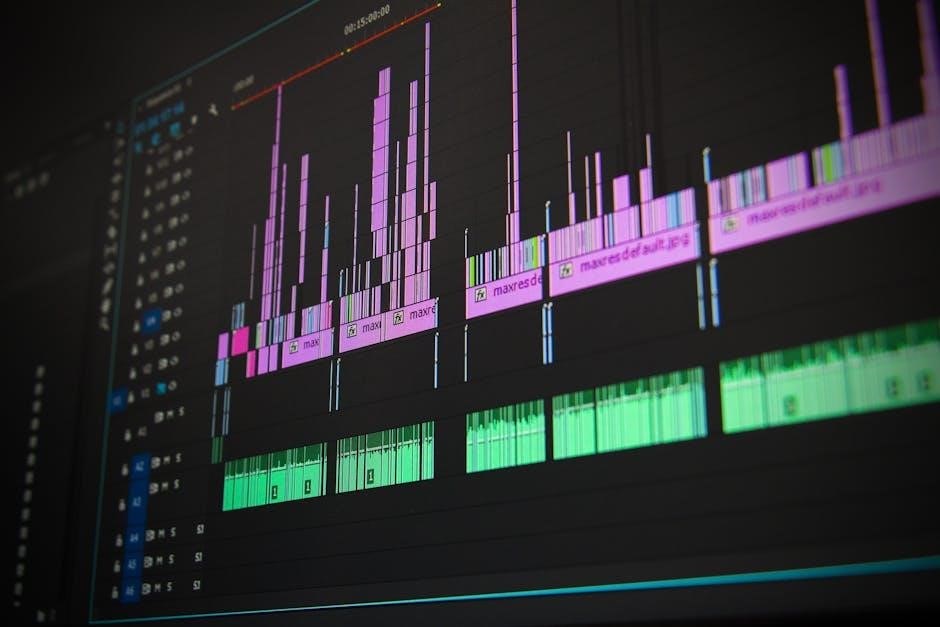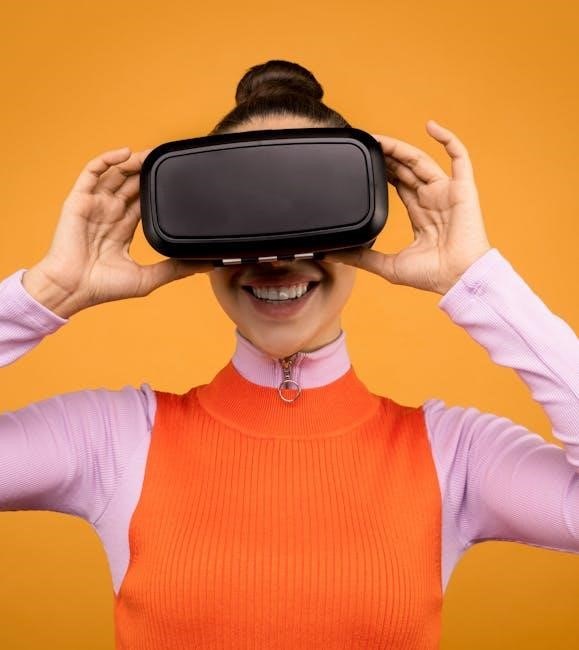The third edition of Fundamentals of Media Effects by Jennings Bryant and Bruce W. Finklea, published by Waveland Press in 2022, explores media influence through historical overviews and foundational theories, offering a comprehensive yet accessible guide for understanding media’s role in society.
1.1 Overview of the Book and Its Significance
Fundamentals of Media Effects, Third Edition, authored by Jennings Bryant and Bruce W. Finklea, is a comprehensive guide to understanding media influence. Published by Waveland Press in 2022, this 496-page book provides an updated exploration of media effects, blending historical context with contemporary research.
Significantly, it addresses the evolving role of media in shaping public opinion, behavior, and cultural norms. The book is designed to be accessible for undergraduates while offering detailed insights, making it a valuable resource for both students and scholars in communication and media studies.
1.2 Importance of Media Effects in Modern Society
Media effects play a pivotal role in shaping modern society by influencing public opinion, behavior, and cultural norms. In today’s interconnected world, media serves as a primary source of information, enabling individuals to form opinions on politics, social issues, and global events. The significance of media effects lies in their ability to sway attitudes, foster empathy, or create division. For instance, media coverage of health crises, such as the COVID-19 pandemic, has profoundly impacted public health behavior and policy decisions. Understanding media effects is crucial for navigating the complexities of modern communication, where information dissemination shapes societal dynamics and individual decision-making processes.

Historical Overview of Media Effects
The study of media effects began with early theories like the hypodermic needle model, evolving through agenda-setting and uses and gratifications theory, reflecting changing media landscapes and technological advancements.
2.1 Early Theories and Concepts of Media Influence
Early theories of media influence, such as the hypodermic needle model, suggested direct and powerful effects of media on audiences. This model posited that media messages were injected into passive recipients, shaping their beliefs and behaviors uniformly. Over time, this simplistic view gave way to more nuanced theories like the agendasetting theory, which emphasized media’s role in influencing what issues the public considers important, rather than dictating specific beliefs. These foundational theories laid the groundwork for understanding the complex dynamics of media effects, acknowledging both direct and indirect influences on individuals and society.
2.2 Evolution of Media Effects Research Over Time
Media effects research has evolved significantly over the decades, moving from simplistic models to more complex theories. Early studies focused on direct effects, like the hypodermic needle theory, which assumed media messages were injected into passive audiences. As research progressed, scholars recognized the active role of audiences, leading to theories such as uses and gratifications and agenda-setting. The rise of digital media and social platforms further expanded the scope, emphasizing interactive and fragmented communication. Today, media effects research considers diverse factors, including individual differences, contextual influences, and technological advancements, offering a more nuanced understanding of media’s dynamic and multifaceted impact on society.

Key Theories in Media Effects
The third edition outlines major theories like the hypodermic needle, agenda-setting, uses and gratifications, social learning, and framing, explaining media’s influence on audiences.
3.1 The Hypodermic Needle Theory
The Hypodermic Needle Theory, also known as the “magic bullet” theory, suggests that media messages are injected directly into audiences, influencing their thoughts and behaviors uniformly. This theory emerged in the early 20th century, proposing a direct and powerful media effect. It assumes a passive audience that absorbs messages without resistance. Critics argue that this theory oversimplifies media influence, neglecting individual differences and contextual factors. Despite its limitations, it remains a foundational concept in media effects research, highlighting the potential power of media to shape public opinion and behavior in a predictable manner.
3.2 Agenda-Setting Theory
The Agenda-Setting Theory proposes that media has the power to influence public perception by determining which issues are most important. It suggests that by highlighting certain topics, media outlets shape the public’s agenda, affecting what people think about and prioritize. This theory emphasizes the media’s role in setting the boundaries of public discourse. First introduced in the 1960s, it has evolved to account for the complexities of modern media landscapes, including the rise of digital platforms. The theory underscores how media can shape public opinion by selectively amplifying specific narratives, thereby influencing societal attitudes and behaviors in profound ways.
3.3 Uses and Gratifications Theory
The Uses and Gratifications Theory focuses on how individuals actively seek and use media to satisfy their needs and desires. Unlike other theories, it emphasizes the audience’s proactive role in media consumption. People use media for various purposes, such as information, entertainment, or social interaction. This theory highlights the diversity of audience needs and the multiple functions media serve. By understanding these uses and gratifications, researchers can better explain why different individuals respond differently to the same media content. This approach provides a user-centric perspective, contrasting with theories that view audiences as passive recipients of media influence.
3.4 Social Learning Theory
Social Learning Theory, developed by Albert Bandura, explains how individuals learn behaviors by observing and imitating others. In the context of media effects, this theory suggests that people acquire attitudes, beliefs, and behaviors by watching media portrayals. Media often serves as a model, demonstrating actions and their consequences, which viewers may then replicate. The theory emphasizes the role of reinforcement, with behaviors more likely to be adopted if they are rewarded or seen as desirable. This perspective highlights the potential of media to shape behavior through observational learning, making it a key framework for understanding media’s influence on individual and societal behavior patterns.
3.5 Framing Theory
Framing Theory, introduced by Erving Goffman and developed by Robert Entman, examines how media present information through specific frameworks or “frames” that influence public perception. By emphasizing certain aspects of a story while ignoring others, media shape audience interpretations and judgments. Frames can affect emotions, beliefs, and decisions, making them powerful tools for swaying public opinion. This theory underscores the media’s role in constructing reality, highlighting the importance of understanding how information is packaged and delivered. It remains a crucial concept in media effects research, offering insights into how framing impacts societal attitudes and behaviors in various contexts.
Research Spotlights and Case Studies
This edition includes spotlights on classic studies, modern research, and real-world cases, examining media’s impact on political polarization and health crises, offering valuable comprehensive insights.
4.1 Classic Studies on Media Influence
The third edition highlights seminal research, such as the “Hollywood in World War II” study, demonstrating media’s power in shaping public attitudes. These studies illustrate how media can influence beliefs and behaviors, providing a foundation for understanding modern media effects. The book also explores the “limited effects” theory from the 1940s, revealing how media shapes opinions indirectly. These classic studies offer timeless insights into media’s role in society, emphasizing its ability to sway public sentiment and cultural norms without direct coercion. By examining these historical cases, readers gain a deeper understanding of media’s enduring impact on individuals and communities.
4.2 Modern Research on Media Effects
Modern research in the third edition emphasizes the evolving nature of media effects, particularly in the digital age. Studies focus on how social media platforms influence public opinion, behavior, and political engagement. The rise of fake news and misinformation has become a critical area of investigation, revealing how rapid content dissemination can shape perceptions. Additionally, research explores the impact of personalized content and algorithms on media consumption patterns. These contemporary studies highlight the dynamic interaction between media technologies and societal change, offering insights into how modern media continues to shape beliefs and behaviors in unprecedented ways.
4.3 Case Studies in Media Influence
The third edition highlights real-world case studies illustrating media’s influence on society. From the impact of news coverage during the COVID-19 pandemic to the role of media in political polarization, these studies demonstrate how media shapes public opinion and behavior. For instance, the book examines how media framing of health crises influenced public health behaviors. Additionally, case studies explore media’s role in social movements, showing how targeted messaging can drive societal change. These examples provide practical insights into the theories discussed, offering a clear understanding of media effects in action and their broader implications for modern society.

The Influence of Media on Beliefs and Behavior
Media significantly shapes public opinion and behavioral patterns by influencing beliefs and attitudes. It plays a crucial role in framing perceptions, guiding actions, and fostering social change, especially during crises like a global pandemic.
5.1 Media’s Role in Shaping Public Opinion
Media plays a pivotal role in shaping public opinion by framing issues, setting agendas, and influencing perceptions. Through selective coverage and narrative framing, media outlets can sway attitudes on political, social, and cultural matters. The third edition highlights how media’s ability to amplify certain voices and stories can shape collective beliefs. During events like elections or global crises, such as a pandemic, media’s influence becomes even more pronounced. The book emphasizes how understanding these dynamics is crucial for critically engaging with information and recognizing the power of media in molding public sentiment and decision-making processes in modern society.
5.2 Media’s Impact on Behavioral Patterns
Media significantly influences behavioral patterns through representation, persuasion, and normalization of actions. The third edition discusses how exposure to media content, such as violence or health campaigns, can alter behaviors. Social learning theory is highlighted, explaining how individuals model behaviors observed in media. Additionally, media’s role in promoting or discouraging behaviors during crises, like a global pandemic, is explored. The book underscores how media’s impact extends beyond awareness to actionable changes, shaping habits and responses to societal challenges. This section emphasizes the dual potential of media to drive positive and negative behavioral shifts, depending on content and context.
5.3 The Role of Media in Social Change
Media plays a pivotal role in driving social change by amplifying messages, raising awareness, and influencing public discourse. The third edition highlights how media platforms empower movements, such as those advocating for social justice or environmental reform. Through framing and agenda-setting, media shapes perceptions of key issues, inspiring collective action. Historical and contemporary examples illustrate how media has mobilized communities, challenged norms, and fostered progress. However, media’s influence can also be manipulative, reflecting power dynamics and biases. The book explores this duality, emphasizing media’s potential to both unify and divide societies in pursuit of change.

The Role of Media in a Polarized Electorate
Media significantly influences opinions and shapes public perception of political issues, often amplifying divisions and reinforcing biases in a polarized society.
6.1 Media’s Role in Political Polarization
Media plays a significant role in political polarization by amplifying selective information, creating echo chambers, and reinforcing partisan identities. Through selective coverage and framing, media outlets often cater to specific audiences, deepening ideological divides. This polarization is further exacerbated by the rise of social media platforms, where algorithms prioritize sensational or divisive content. As a result, individuals become more entrenched in their beliefs, leading to increased political fragmentation. The third edition of Fundamentals of Media Effects highlights how media’s role in shaping public opinion contributes to societal divisions and challenges the notion of objective information dissemination in a polarized world.
6.2 The Impact of Media on Voting Behavior
Media significantly influences voting behavior by shaping public opinion and candidate perceptions. Through agendas, framing, and selective reporting, media outlets can sway voter preferences. The third edition of Fundamentals of Media Effects discusses how exposure to biased or slanted news can alter electoral decisions. Social media platforms further amplify this effect by spreading misinformation and targeting specific demographics. Consequently, media’s role extends beyond information dissemination to active persuasion, making it a critical factor in election outcomes and political engagement. This underscores the necessity of media literacy to counteract potential manipulation and ensure informed decision-making among voters.

Media’s Role in a Global Pandemic
Media plays a crucial role in disseminating information during global health crises, influencing public perception and behavior. The third edition highlights how media shapes understanding of pandemics, ensuring accurate information reaches the masses to guide health decisions and maintain trust in authorities.
7.1 Media Coverage of Health Crises
Media coverage of health crises, such as the COVID-19 pandemic, shapes public understanding and response. The third edition highlights how media balances accuracy and sensationalism, influencing perceptions of risk and trust in health authorities. Effective communication strategies, including coordination with experts, are emphasized to ensure clarity and reduce misinformation. The role of media in disseminating critical information, such as vaccination updates and safety measures, is explored, underscoring its impact on public behavior and decision-making during emergencies. The book examines how media narratives can either amplify or mitigate panic, illustrating the delicate balance required in reporting health crises.
7.2 The Impact of Media on Public Health Behavior
Media significantly influences public health behavior by shaping perceptions and actions during crises. The third edition explores how media messages encourage adherence to health guidelines, such as vaccination and mask-wearing, while also addressing the spread of misinformation. The book highlights strategies to enhance public health communication, ensuring clarity and accuracy. Media’s role in promoting preventive behaviors and fostering community resilience is examined, alongside its potential to amplify risks through sensationalism. By analyzing real-world examples, the text underscores the importance of responsible media practices in guiding public health responses and reducing harmful behaviors during pandemics and other health emergencies.

The Potential of Media to Influence Beliefs and Behavior
Media holds immense power in shaping beliefs and behaviors through information dissemination and cultural influence, as highlighted in the third edition of Fundamentals of Media Effects.
8.1 The Power of Media in Information Dissemination
The media’s ability to disseminate information swiftly and widely underscores its significant influence on public perception and behavior. As discussed in the third edition of Fundamentals of Media Effects, media platforms serve as primary sources of news and knowledge, shaping how individuals process events and ideas. Through various channels, media can amplify certain narratives while minimizing others, thereby influencing collective beliefs and attitudes. This power is particularly evident in its coverage of global events, such as elections and pandemics, where media not only informs but also sways public opinion and decision-making.
The book highlights how this dissemination of information can foster both informed dialogue and misinformation, emphasizing the dual-edged nature of media influence in contemporary society.
8.2 Media’s Role in Shaping Cultural Norms
Media significantly influences cultural norms by representing and reinforcing societal values, behaviors, and beliefs. Through television, film, and social media, media platforms shape perceptions of what is acceptable or desirable. The third edition of Fundamentals of Media Effects explores how media can normalize certain behaviors while stigmatizing others, thereby altering cultural standards over time. This influence is evident in depictions of gender roles, racial stereotypes, and social trends. Media’s role in reflecting and reshaping cultural norms highlights its power to drive gradual shifts in societal attitudes, fostering both continuity and change in cultural identity and collective values.

The Authors and Their Contributions
Jennings Bryant and Bruce W. Finklea are renowned scholars whose work in Fundamentals of Media Effects provides foundational insights into media influence, shaping academic and public understanding.
9.1 Jennings Bryant and His Work in Media Effects
Jennings Bryant is a prominent scholar in media effects research, known for his extensive work in understanding media’s influence on society. Co-authoring Fundamentals of Media Effects, Bryant provides deep insights into historical and theoretical foundations. His work emphasizes the role of media in shaping public opinion and behavioral patterns, making it a vital resource for both academics and students. Bryant’s contributions have significantly advanced the field, offering a comprehensive understanding of media’s impact on individuals and communities. His collaborative approach with Bruce W. Finklea ensures the book remains accessible while maintaining academic rigor, making it indispensable for studying media effects.
9.2 Bruce W. Finklea’s Contributions to Media Research
Bruce W. Finklea is a distinguished researcher and co-author of the Fundamentals of Media Effects series. His work focuses on the theoretical and practical aspects of media influence, offering critical insights into how media shapes public perception and behavior. Finklea’s contributions have been instrumental in advancing media effects research, particularly in areas such as agenda-setting and social learning theories. His collaborative efforts with Jennings Bryant have produced a seminal text that bridges academic depth with reader accessibility. Finklea’s research emphasizes the dynamic interaction between media and society, providing valuable perspectives for both scholars and practitioners in the field of media studies.

Structure of the Book
The third edition is organized into chapters, beginning with historical overviews and progressing through theories, research spotlights, and modern applications, ensuring a logical flow for comprehensive understanding.
10.1 Chapter-by-Chapter Overview
The third edition of Fundamentals of Media Effects is structured to guide readers through key concepts systematically. The book begins with an introduction to media effects, followed by historical context and foundational theories. Subsequent chapters delve into specific theories like agenda-setting, uses and gratifications, and social learning. The text also includes research spotlights and case studies, providing real-world applications of media influence. Later chapters explore media’s role in shaping public opinion, behavioral patterns, and social change, as well as its impact on political polarization and global health crises. The final sections discuss the broader implications of media effects and future research directions.
10.2 Key Features of the Third Edition
The third edition of Fundamentals of Media Effects enhances its predecessor with new research, theories, and a focus on contemporary media issues. It incorporates updated data on media’s role in political polarization and global pandemics, offering fresh insights into current communication trends. The book features research spotlights and case studies that provide practical examples of media influence. Additionally, it includes enhanced coverage of digital media and its impact on society. These updates ensure the text remains relevant and accessible for undergraduates, making it a valuable resource for understanding the evolving landscape of media effects in the modern world.
The Third Edition Updates
The third edition introduces new research, updated theories, and enhanced focus on current media issues, ensuring relevance in understanding media’s evolving role in society today.
11.1 New Research and Theories Included
The third edition incorporates cutting-edge research and contemporary theories, offering fresh insights into media effects. It delves into recent studies on social media influences, political polarization, and global health crises, providing readers with a comprehensive understanding of modern media dynamics. Enhanced sections on information dissemination and cultural norm shaping highlight the evolving power of media. These updates ensure the book remains a vital resource for students and scholars seeking to understand the complex and ever-changing landscape of media effects in today’s interconnected world.
11.2 Enhanced Focus on Current Media Issues
The third edition places a strong emphasis on pressing contemporary media topics, ensuring relevance for today’s students. It addresses issues like the role of media in a polarized electorate and its impact during global pandemics. The book also explores the influence of social media platforms on public opinion and behavior. By focusing on these timely subjects, the edition bridges theoretical foundations with real-world applications, making it an essential tool for understanding how media shapes society in the modern age. This updated approach ensures readers gain a nuanced perspective on the dynamic and evolving nature of media effects.

The Broader Implications of Media Effects
Fundamentals of Media Effects, Third Edition highlights media’s global influence, addressing its role in public opinion, cultural norms, and social change. It underscores media’s power in shaping perceptions and behaviors, emphasizing its significance in today’s interconnected world while exploring future research directions to understand media’s evolving impact on society.
12.1 Media’s Role in Global Communication
Media serves as a vital bridge in global communication, enabling the rapid dissemination of information across borders. As highlighted in the third edition, media’s role extends beyond national boundaries, facilitating cultural exchange and fostering understanding among diverse populations. The book emphasizes how global media networks shape perceptions of international events, influence public opinion, and contribute to the spread of ideas. This interconnectedness underscores the media’s power in promoting global dialogue and addressing universal challenges, making it an indispensable tool in today’s interconnected world.
12.2 The Future of Media Effects Research
The future of media effects research lies in understanding the evolving dynamics of media influence in a rapidly changing world. As digital platforms dominate communication, research will focus on the impact of social media, algorithms, and AI-driven content. The third edition highlights the need for interdisciplinary approaches to study media’s role in shaping global communication and cultural norms; Emerging technologies and globalization will require innovative methodologies to assess media effects accurately. This evolving field will continue to explore how media shapes beliefs, behaviors, and societal structures, ensuring its relevance in addressing future challenges and opportunities in communication and global understanding.
